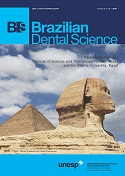Synthesis and morphological characterization of Polycaprolactone (PCL) membranes with tara extract (Caesalpinia spinosa)
DOI:
https://doi.org/10.14295/bds.2019.v22i2.1688Resumo
Objective: This study aimed the synthesis and morphological characterization of PCL electrospun fibers containing tara extract. Material and Methods: For this, tara extract synthesis was performed by two different extraction methods: rotary evaporator and extractor soxhlet. Then, two solutions were prepared by dissolving 3g of PCL in 2mL of Acetone. The first solution used 0.4 mL tara extract obtained by RE and the second solution used 0.4 mL tara extract obtained by SE. After the solutions electrospinning, under different parameters, obtaining It was obtained the experimental groups: ChTa 1 nanofibers with RE extract, under 12 Kv; ChTa 2 nanofibers with RE extract, under 15 Kv; ChTa 3 nanofibers with ES extract, under 12Kv and ChTa 4 nanofibers with ES extract, under 15kV. Scanning electron micrographs were performed for morphological analysis. Results: Fiber formation was observed for all parameters. About the fiber diameter: ChTa 1 presented a mean of 0.82 ± 0.36?m, ChTa 2 1.232 ±0471?m, ChTa 3 1.469 ± 0.614?m and ChTa 4 1.017 ± 0.417. Also the beads formation was analyzed: ChTa 1 group presented 8 beads, ChTa 2 presented 5, ChTa 3 presented 30 and ChTa 4 presented 15 beads. Conclusion: It can be concluded that it is possible to obtain an effective synthesis of electrospun membranes of PCL and Caesalpinia spinosa extract, indicating a potential of therapeutic application for lesions such as prosthetic stomatitis.
Keywords
Candidiasis; Nanofibers; Tannins.
Downloads
Downloads
Publicado
Como Citar
Edição
Seção
Licença
TRANSFERÊNCIA DE DIREITOS AUTORAIS E DECLARAÇÃO DE RESPONSABILIDADE
Toda a propriedade de direitos autorais do artigo "____________________________________________________________________" é transferido do autor(es) para a CIÊNCIA ODONTOLÓGICA BRASILEIRA, no caso do trabalho ser publicado. O artigo não foi publicado em outro lugar e não foi submetido simultaneamente para publicação em outra revista.
Vimos por meio deste, atestar que trabalho é original e não apresenta dados manipulados, fraude ou plágio. Fizemos contribuição científica significativa para o estudo e estamos cientes dos dados apresentados e de acordo com a versão final do artigo. Assumimos total responsabilidade pelos aspectos éticos do estudo.
Este texto deve ser impresso e assinado por todos os autores. A versão digitalizada deverá ser apresentada como arquivo suplementar durante o processo de submissão.




























